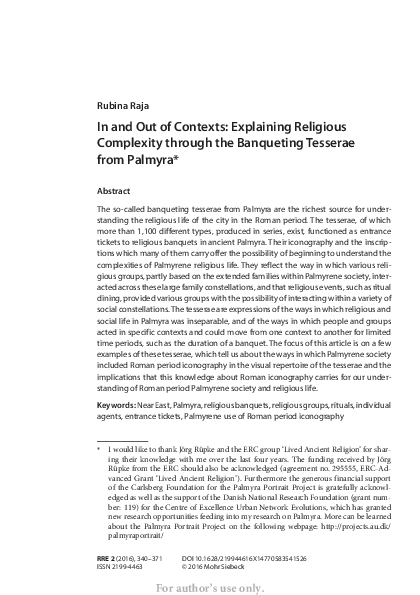The Significance of Objects: Considerations on Agency and Context
New publications by Rubina Raja.

Raja, R. (2016). In and out of contexts: Explaining religious complexity through the canqueting tesserae from Palmyra. In Raja, R. & L. Weiss (eds.), The Significance of Objects: Considerations on Agency and Context. Special issue of Religion in the Roman Empire. Mohr Siebeck, 340-371.
Raja, R. & Weiss, L. (eds.) (2016). The Significance of Objects: Considerations on Agency and Context. Special issue of Religion in the Roman Empire. Mohr Siebeck.
Raja, R. & Weiss, L. (2016). The Significance of Objects: Considerations on Agency and Context. In Raja, R. & L. Weiss (eds.), The Significance of Objects: Considerations on Agency and Context. Special issue of Religion in the Roman Empire. Mohr Siebeck, 297-306.
Abstract (Raja 2016)
The so-called banqueting tesserae from Palmyra are the richest source for understanding the religious life of the city in the Roman period. The tesserae, of which more than 1,100 different types, produced in series, exist, functioned as entrance tickets to religious banquets in ancient Palmyra. Their iconography and the inscriptions which many of them carry offer the possibility of beginning to understand the complexities of Palmyrene religious life. They reflect the way in which various religious groups, partly based on the extended families within Palmyrene society, interacted across these large family constellations, and that religious events, such as ritual dining, provided various groups with the possibility of interacting within a variety of social constellations. The tesserae are expressions of the ways in which religious and social life in Palmyra was inseparable, and of the ways in which people and groups acted in specific contexts and could move from one context to another for limited time periods, such as the duration of a banquet. The focus of this article is on a few examples of these tesserae, which tell us about the ways in which Palmyrene society included Roman period iconography in the visual repertoire of the tesserae and the implications that this knowledge about Roman iconography carries for our understanding of Roman period Palmyrene society and religious life.
